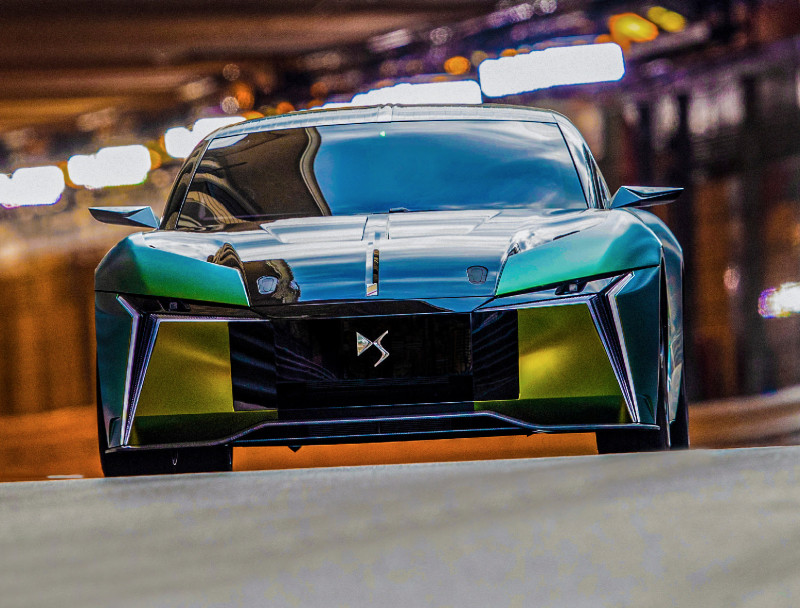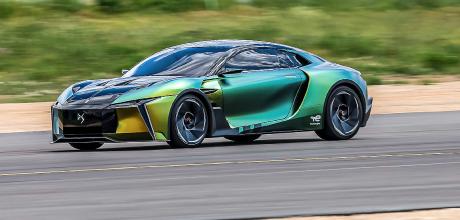800bhp 2023 DS E-Tense Performance
It has 800bhp, does without brakes and is shaping future DS road and race cars. We drive the E-Tense Performance.
SECOND-LIFE LIVEWIRE DS
Words James Taylor
The not-quite-green, not-quite-gold supercar flashes by, with the shrill whine of two electric motors in its wake. Special particles in its paint subtly shift its colour, chameleon-like, under the Mediterranean sunshine. Heads in grandstands swivel and doubletake, even here in supercar-saturated Monte Carlo. In a few moments qualifying gets underway for the 2022 Formula E Monaco E-Prix, but first the DS E-Tense Performance concept car is tearing around the circuit in a high-speed demo run. Time is tight in the Formula E schedule: someone important must have pulled some strings here.

Laps concluded (including a flamboyantly sideways exit from the final corner), the DS whirs to a halt in the paddock like a creation from a sci-fi movie. Out of the driver’s seat hops a race-suited Carlos Tavares, CEO and string-puller-in-chief at industry giant Stellantis, parent company of DS Automobiles. The E-Tense Performance (let’s call it the E-TP from now on, to save ink) is a genuinely fascinating project for DS, because it’s a car with a double life. By night, it’s a spectacular concept car foreshowing design cues for DS’s next generation of road cars (expect its front and rear light treatment to reappear in similar form on 2024 DS models). But its new day job is even more interesting: to be a hard-working test car to trial innovative engineering for both future electric road cars and DS’s next-gen Formula E racing car. While most concept cars live a life ferried from show stand to show stand and are rarely driven at speed (if they’re driveable at all), this one’s already been belting around test tracks trialling a game-changing braking system.
If you have a sense of déjà vu, that’s because it’s not the first time the E-TP has been shown to the world. This is something of a second life for the concept, as it first appeared in 2016 (when its original face previewed that of the DS 7 crossover). Around 18 months ago, DS’s Performance division was in search of an ideal driveable test bed for EV technology. Specifically, a clever regen system for the 2023 season’s third-generation Formula E car, as well as future roadgoing EVs.
Time for the E-TP to come out of semi-retirement, and get a facelift to go with its technical overhaul. Its design details are stunning close up but it’s the way it drives that’s most intriguing.
Tavares is all smiles. ‘What we all need to realise is that you can make thrilling sports cars with electric powertrains,’ he tells CAR. ‘You have a kick of acceleration which is outstanding – in fact, much better than a combustion engine; you have a much smoother ride, because there’s less noise, reduced vibrations – enjoyable for a gran turismo product; and your centre of gravity is very low, so the lateral grip is very high – what more do you need?
‘I can testify that an electric sports car is a much better car than a conventional sports car,’ he continues. ‘We just need to fix the problem of weight, because the [electric] cars are too heavy. That is the major problem we are going to be facing for the next 10-20 years.’ Too heavy isn’t a criticism that could be levelled at the E-TP, which weighs around 1200kg. Built around a carbon monocoque, it features two motors taken from DS’s Formula E racers. The front motor packs 335bhp, same as the racing car, and the rear is upped to 470bhp, for an 805bhp total. The battery, specially made by partner Total Energies, is small and weighs around 250kg. That’s because this car isn’t about range, the decisive factor in roadgoing EV batteries at present; it’s thinking in terms of the further future when rapidcharging stations will be more plentiful and lighter batteries – and therefore lighter, more efficient cars – will be a viable option.
Besides, the E-TP hasn’t been designed as a roadgoing model. Not that there hasn’t been interest: ‘If we were to produce a road version, it would be very expensive – more than €1m,’ says DS CEO Béatrice Foucher. ‘For 10, 30 or 50 cars we could find clients – but nothing’s been decided. Our priority is to focus on the next generation of road cars, putting in place energy management insights from this car; after that we’ll see.’
Tavares and Foucher hurry to the DS Techeetah Formula E team garage to oversee the action from the pitlane. Their cars will go on to finish third and 11th, leaving Monaco holding second place in both drivers’ and teams’ championship standings.
Meanwhile, we’re on our way to a location without the constraints of Monaco’s barriers. Some more strings have been pulled: Le Castellet airport’s runway is ours and CAR is behind the DS E-TP’s wheel. The same wheel, in fact, as is found in DS’s Formula E cars, and one we’re not allowed to photograph for fear of other teams getting too good a look at it. The rest of the interior is pure concept car, with alien-like organic latticework surfacing across the dashboard. Some concept cars are rough and ready up close but everything feels lovely here. The infotainment even works.
Alongside me is Alexandre Bengué, rally ace and DS development driver. This car represents a significant investment for DS – hence the runway setting and chaperone in the passenger seat. The battery itself is expensive, partly because it can handle up to 600kW of regenerative power under deceleration. And what’s fascinating about this mega regen capability is what it means for braking. Although there are discs and pads within the aero-surfaced wheels they’re all but redundant, in play only in an absolute emergency stop from maximum speed. Practically all braking is done on motor regen alone, harvesting kinetic energy as the car decelerates and feeding it back into the battery. The team assure me I’ll be able to touch the discs after my run and they’ll be stone cold. Let’s find out.
Leaving the hangar that’s our temporary pit garage, the motors’ and transmission’s intense whine increases exponentially with speed. This is not a silent EV. The steering is ultra-sensitive, far more direct than any road car I’ve ever driven, due to its motorsport-spec geometry. It takes concentration to prevent the car wandering at speed. And what speed. Push the accelerator smoothly to the floor and response is equally smooth, and instant. The whine intensifies and speed builds equally intensely. Without the context of trees or road furniture whipping past the runway’s vast environs it’s hard to contextualise the speed. But it’s clearly Very Fast.
Let’s try this braking system. The pedal needs a firm press with a lot of pressure. But the remarkable thing is how normal it otherwise feels to press that pedal, and how natural is the response you get from the motors in return. There’s no pushing of hydraulic fluid and calipers. Pad wear or disc temperature don’t matter. The only limiting factors in braking are tyre condition and the road surface. But going is always more fun than stopping, and Alex motions at me from the passenger seat. ‘Would you like to try a launch?’ Bien sur.
Bring the car to a halt, pull the bottom-left paddle behind the wheel, then flatten the accelerator pedal, he instructs. Take a deep breath, and release the paddle. Jeez. I’ve experienced some rapid acceleration but this… The E-TP can theoretically get from 0-62mph in less than two seconds. That feels entirely believable. After all, it can generate as much as 5900lb ft of torque. How much of that twist can be transmitted to the tarmac is limited by tyres (road-spec Michelin Pilot Sport 4S) and driveshaft strength.
Handling exploration is limited to improvised hairpins at either end of the runway, but the low centre of gravity and light weight are immediately apparent. I can see what Tavares was talking about back in Monaco. From here the E-TP will be whisked to a private test track, ready for DS Formula E driver Jean-Eric Vergne to take over development driving duties. What a second life for a concept car. And what it might mean for future EV road cars: ‘The regen software is a new space for optimisation, and differentiation across different car makers,’ says Tavares. ‘Which is great – that’s what we like, right?’
NEED TO KNOW
The story so far…
Citroën’s side-hustle, spun off as a brand in its own right in 2014.
Explain the ranking…
Genuinely avant-garde in both interior and exterior design and likeably different but feels like an enjoyably quirky cog in the Stellantis machine rather than a relevant power in its own right.
DS in three words...
Alternative French luxury. Best car/finest hour… The company takes its name from the odd but innovative, stylish and intensely French Citroën DS of the ’50s (pictured).
Darkest hour…
The world’s ‘Huh? Why?’ response when the company was first announced as a standalone brand.
The future looks…
Electric. All new DS models from 2024 onwards will be fully electric, and combustion models will be phased out.
Alex Bengué (left) is chief test driver. James isn’t That face will reappear on DS road cars Hit the left pedal and you slow down with motors, not mechanical brakes.
THE DISCS AND PADS 59 ARE BARELY USED; THE E-TENSE BRAKES ON REGEN ALONE
TAKE A DEEP BREATH. I’VE EXPERIENCED RAPID ACCELERATION IN OTHER CARS BUT THIS… JEEZ
E-Tense is DS’s name for its electrified models – at least until they’re all electrified.
‘Don’t press this one; or this one...’ James gets the pre-flight briefing Digital instrument panel is slick. It works, too.
ROAD ME ETS RACE
The E-Tense Performance takes much of its technology from DS’s Formula E programme. The French brand has a stellar record in the electric racing championship, joining in 2015 and winning both the drivers’ and teams’ titles in two of the last three seasons.
Says CEO Béatrice Foucher: ‘There is still more to do, demonstrating the evolution of electric cars, and this is a kind of laboratory. It explains that if you want to race, to be efficient, you have to manage the energy. And the electric car is about energy management – that’s where you make the difference.’ DS is on board with the series until at least 2026. Aside from taking its motors from Formula E, the E-Tense concept will feed research back into DS’s next-gen racing car, which will incorporate front-axle regen using lessons learned partly in this concept car’s test programme.


